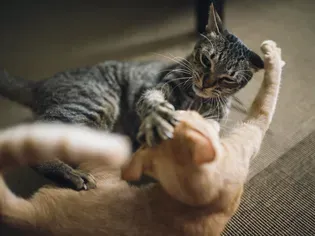Play vs. Aggression Between Cats: What's the Difference?
Updated on 04/26/24

Play vs. Aggression Between Cats: Unveiling the Subtle Differences
Cats are fascinating creatures known for their playful antics and independent spirits. However, differentiating between playful and aggressive behavior can be challenging at times, especially for new cat owners. Understanding these subtle differences is crucial for creating a harmonious and stress-free environment for your feline companion.
Defining Play and Aggression
Play is a natural and essential behavior for cats. It serves multiple purposes, such as:
* Socialization: Kittens learn social cues and boundaries through play.
* Exercise and Development: Play provides physical and mental stimulation, promoting dexterity and coordination.
* Stress Relief: Play can help cats release pent-up energy and reduce boredom.
Aggression, on the other hand, is a defensive response triggered by feelings of fear, threat, or dominance. It can manifest in various forms, including:
* Defensive: Cats may lash out to protect themselves from perceived threats.
* Predatory: Instinctive hunting behaviors can trigger aggression in some cats.
* Redirected: Aggression can be redirected at innocent bystanders after an initial trigger.
Key Differences Between Play and Aggression
While play and aggression can overlap in certain aspects, there are several key differences to watch for:
* Body Language: Playful cats often have relaxed bodies, dilated pupils, and swishing tails. Aggressive cats may exhibit tense posture, flattened ears, and a rigid tail.
* Vocalization: Playful cats typically produce high-pitched chirps, trills, or meows. Aggressive cats may growl, hiss, or spit.
* Intent: Play is usually mutual and enjoyed by both cats. Aggression, on the other hand, is one-sided and intended to deter or harm.
* Duration: Playful episodes tend to be brief and intermittent, with pauses and breaks. Aggressive behavior can be more sustained and intense.
* Context: Playful interactions often involve toys, chasing, or mock hunting. Aggression typically occurs in response to specific triggers, such as territory disputes or resource guarding.
Examples of Common Play and Aggressive Behaviors
Play:
* Chased by a toy: Cats chasing a toy while exhibiting playful body language.
* Pouncing on a cat companion: Kittens playfully jumping on each other, engaging in mock fights.
* Bite-and-release: Gentle nibbling and releasing between two cats, without causing any pain.
Aggression:
* Territorial defense: A cat hissing and arching its back towards an unfamiliar cat entering its perceived territory.
* Resource guarding: A cat growling while protecting its food bowl from another cat.
* Fear reaction: A cat lashing out at a stranger who approaches it too quickly.
Managing Play and Aggression
Understanding the differences between play and aggression empowers you to respond appropriately and ensure the well-being of your cats. Here are some tips for managing both behaviors:
* Provide Ample Play Opportunities: Offer interactive toys, scratching posts, and play sessions to channel your cat's playful nature.
* Establish Boundaries: Set clear rules and enforce them consistently to prevent play from escalating into aggression.
* Control Environments: Manage potential triggers, such as shared food bowls or crowded spaces, to minimize the risk of aggression.
* Seek Professional Help: If you're struggling to differentiate between play and aggression, or if aggressive behavior persists or worsens, consult a veterinarian or certified animal behaviorist for professional guidance.
By understanding the subtle differences between play and aggression, you can create a safe and harmonious environment for your feline friends. This knowledge empowers you to appreciate their playful antics while recognizing and addressing any potential aggressive behaviors. Remember, early intervention is crucial in preventing escalation and promoting a happy and healthy cat household.
Explore More Pets

Cat Behavior Problems
How to Stop Aggression in Kittens

Long-Haired Cat Breeds
Siberian Cat: Breed Profile, Characteristics, & Care

Cat Behavior Problems
How to Stop Kittens From Scratching and Biting

Long-Haired Cat Breeds
Turkish Angora: Cat Breed Profile, Characteristics & Care

Basic Training
How to Socialize Your Kitten

Short-Haired Cat Breeds
Cute Pictures & Facts About Calico Cats & Kittens

Litter Box Training
Training Your Kitten to Use the Litter Box

Long-Haired Cat Breeds
10 Fun Facts About White Cats